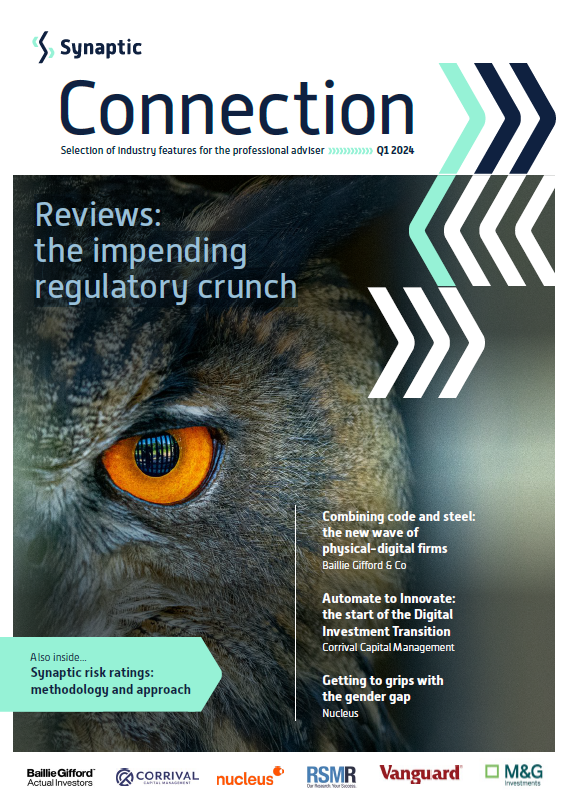In this edition...
- Synaptic and how to deal with the impending regulatory crunch around reviews Eric Armstrong, Client Director - Synaptic
- Combining code and steel: the new wave of physical-digital firms Kirsty Gibson, Investment Manager - Baillie Gifford & Co
- Automate to Innovate: the start of the Digital Investment Transition Nick Skelhorn, Founder Corrival - Capital Management
- Getting to grips with the gender gap Laura Barnes , Director of Business Development - Nucleus Financial Platforms
- Hunt’s budget pleases hardly anyone Jupiter Asset Management,
- The case for multi-asset portfolios is even stronger Lukas Brandl-Cheng, Investment Strategy Analyst - Vanguard Europe
- Investment Perspectives from RSMR: Are you big in Japan? Stewart Smith, Head of Managed Portfolio Services - RSMR
- The case for sustainable investing Maria Municchi, Sustainable Multi Asset Fund Manager - M&G investments
- Synaptic risk ratings: methodology and approach. Risk profiling and asset allocation Eric Armstrong, Client Director - Synaptic
- Hours to minutes Synaptic,
- The first rule of financial planning: insure the breadwinner Synaptic,
- The new Protection for Synaptic Pathways has arrived Synaptic,
 Companies like Amazon and DoorDash are challenging the status quo by blending digital and physical innovation.
Companies like Amazon and DoorDash are challenging the status quo by blending digital and physical innovation.
When you click ‘buy now’ on Amazon, your orders speed to your doorstep thanks to vast amounts of data centre circuitry, miles of automated warehouse conveyor belts and a flotilla of vans and other vehicles.
The company is known as a digital disruptor. But that’s only half the story. While its customers mainly interact with it online, much of Amazon’s competitive advantage comes from its physical operations.
In this regard, it heralded a new wave of disruption, says Kirsty Gibson, an investment manager at Edinburgh based fund manager Baillie Gifford.
“For most of the last century, the leading companies operated almost solely in the physical world, and their competitive advantages were forged by their physical assets and access to capital to fund them,” Gibson explains. “Take, for example, the aviation, energy and newspaper industries.
“Then the proliferation of the internet gave rise to businesses with purely digital business models. They were capital-light and nimble but quite narrow in terms of the sectors they disrupted, including advertising, media and analytics.
“But Amazon was different. It wanted to sell books online but had to build physical infrastructure to do so. And it pursued a similar process when it went into cloud computing. Amazon Web Services is perceived as a digital service, but its strength depends on the firm’s huge investment in data centre hardware.”
Amazon’s effort to bolster its digital offerings with expenditure on physical operations continues to this day, from running its own cargo airline to plans to deploy thousands of satellites into low-earth orbit to provide broadband to communities below.
“Jeff Bezos talked about the idea of customers being ‘divinely discontent’ – their expectations constantly increase,” says Gibson. “So, one of the reasons Amazon has rolled out so much physical infrastructure is that it wants to get you your delivery as fast as possible at the lowest possible price. And we have confidence that the current chief executive Andy Jassy is also willing to take bold, innovative, long-term bets to improve customers’ lives.”
Chemicals and cars
Other examples of companies following Amazon’s lead in intertwining computer code with physical processes include Solugen and Rivian Automotive. The former is attempting to disrupt the industrial chemicals industry by using artificial intelligence software to engineer enzymes, which it then uses to convert sugars into more valuable molecules. Solugen’s advantage over traditional counterparts is that it doesn’t use fossil fuels and avoids creating carbon emissions or waste.
“Solugen’s Bioforge reactor system is a fraction of the size of the colossal manufacturing plants usually required to make chemicals, which helps keep its costs down,” Gibson says. “And because it is modular, the reactors can be rolled out at many more locations.”
Rivian, by contrast, is seeking to disrupt the market for pick-up trucks and sports utility vehicles with its range of electric automobiles.
“It has to build manufacturing plants to build its cars but it’s also all about software,” says Gibson. “For example, it has provided customers with over-the air updates to make towing trailers easier and has upgraded the suspension system to smooth rides. And it’s also investing in self-drive technologies.”
Augmenting, not displacing
Gibson also identifies a second type of company merging the physical and digital realms. “These are firms looking to build upon existing physical infrastructure rather than trying to replace it,” she explains. “They are more capital-light than the other kind but face the challenge of having to convince traditional businesses of their worth.”
DoorDash is one example. It simultaneously provides a service to three different classes of client:
› Consumers wanting meals and convenience store items delivered to their homes.
› Self-employed drivers needing to be told where to pick up and drop off the orders.
› Restaurants and stores supplying the food and other products.
“DoorDash is a digital offering grounded in an understanding of the physical businesses it works with,” Gibson says.
“It’s all about telling drivers the optimum time to arrive, where to park and the most efficient way through a shopping mall. And it also has to know how long restaurants take to prepare a meal. You don’t want drivers waiting ages for pick-ups, but you also don’t want customers complaining that their dinner has arrived cold.”
The company also invests in physical infrastructure. Its DashMart warehouses directly employ staff to stock items and hand them off to the drivers.
“It lets DoorDash continue serving consumers at times when other retailers are closed. This also benefits its self-employed drivers, who often make deliveries to supplement a daytime job,” says Gibson.
Self driving lorries
Aurora Innovation also falls into the second bucket of physical-digital companies.
The driverless lorry pioneer has opted to avoid manufacturing vehicles of its own. Instead, it has partnered with the automotive parts specialist Continental to offer its self-driving hardware and software as a service that takes control of retrofitted rigs. Volvo Trucks and FedEx are among those to have shown an early interest.
“The truck industry faces an inadequate supply of drivers, so there’s a need for this technology. And Aurora has the clear support of industry insiders,” says Gibson.
“But the key to driving costs out of the system will be decreasing the level of remote support it needs to provide over the long-term.”
Not every business needs to merge ‘bits and atoms’ to succeed. Nor is our rationale for investing always based on the paradigm for those that try. Gibson gives Meta as an example of a holding she backed purely because of the long-term growth prospects of its digital efforts rather than its Oculus virtual reality hardware.
However, she adds that asking how companies approach the two worlds can be helpful when considering their prospects over the five-to-tenyear-plus period we aim to be a shareholder on behalf of our clients.
"The companies we invest in need to make farsighted investments themselves, and that often involves committing capital and resources to a combination of physical and digital innovation. Doing so gives them a chance to be transformative and disruptive.”
Discover more of Kirsty Gibson’s thoughts about the digital-physical paradigm by watching the video of her Disruption Week webinar at bailliegifford.com/disruptionweek
Find out more by visiting:
bailliegifford.com
Important Information:
The views expressed should not be considered as advice or a recommendation to buy, sell or hold a particular investment. They reflect opinion and should not be taken as statements of fact nor should any reliance be placed on them when making investment decisions.
This communication contains information on investments which does not constitute independent research. Accordingly, it is not subject to the protections afforded to independent research, but is classified as advertising under Art 68 of the Financial Services Act (‘FinSA’) and Baillie Gifford and its staff may have dealt in the investments concerned.
Baillie Gifford & Co and Baillie Gifford & Co Limited are authorised and regulated by the Financial Conduct Authority (FCA).
Sign up for updates
Keep up to speed with everything you need to know each quarter, by email or post.


